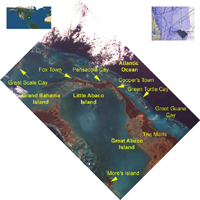
Click on image for larger annotated versionThis image captures the tropical beauty of the major islands of the Little Bahama Bank, the most northerly of the island groups that comprise the Bahamas. The island at the west edge of the image is Grand Bahama Island, which lies 60 miles east of West Palm Beach in Florida and boasts the second largest city in the Bahamas, Freeport. The island takes up an area of 530 square miles and has a population of 40,898 (1990). The economy is, of course, based on tourism and fishing, with a substantial amount of forest products adding to economic exports. The islands taking up the center and southeast edge of the image are Little Abaco and Great Abaco. The Abaco island group takes up 780 square miles, and is the most northerly section of the Bahamas. Most of the water visible in this image is relatively shallow, reaching depths of no more than 200m (650ft). Along the northeastern edge of the photo, however, there is a visible drop off as the depth increases from 200m (650ft) along the Little Bahama Bank to 1000m (3281 ft) in the open Atlantic Ocean.
The islands of the Bahamas rest on a foundation of ancient coral, on top of which is a layer of sandy soil. Towards the interior of the islands, this soil is cemented to form Bahama limestone. Because they are built up merely by sedimentation and coral growth, the landscape is quite flat and only about 20 feet above sea level on average.
Photojournal note:
EarthKAM was formerly known as KidSat. To see images of KidSat, see https://photojournal.jpl.nasa.gov/mission/KidSat .

